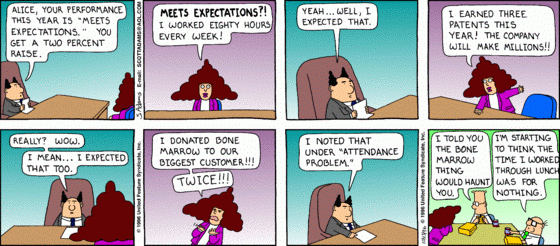Here are three reasons why your employee assessment tools (i.e. annual performance reviews) are failing.
If you’ve ever worked in an office, you can appreciate the themes in the Dilbert comic strip series. Dilbert pokes fun at anything and everything related to management and human resources in the workplace.
It’s very funny stuff that most of us can relate to. And there’s an old saying that goes like this: many a truth is said in jest.
This means that we often say truthful things in a joking manner so other people aren’t offended. But we’re still speaking the truth.
If you have worked in an office for a while you have probably had a performance evaluation once or twice. I found this Dilbert cartoon today and thought it cleverly highlighted employees’ frustrations with performance reviews.
Funny, right? But seriously, there’s truth in this cartoon. It is very frustrating to have your performance undervalued or misinterpreted by your manager/supervisor. There’s plenty of discussion out there about why employee performance reviews fail. Is the problem with the appraisal method itself or with the managers who administer this tool? Maybe both.
According to an article by Business Insider, titled Talent Executive Says Annual Performance Reviews Are Huge Morale Killers, here are a few reasons why performance reviews often fail (and kill employee morale in the process).
#1 – They’re uncomfortable.
Performance appraisals make the person receiving the evaluation AND the person giving the evaluation uncomfortable. It’s mutually uncomfortable for both parties. One has to hear their entire year’s work (or multiple years of work) boiled down to a couple of numbers and the other has to do the boiling down.
#2 – They’re ineffective.
Business Insider goes on to discuss that performance reviews can be really ineffective. Why is that? Because numeric ratings are not always the best indicators of high or low performance. Plus, when an employee is in a meeting waiting to hear about their ratings, chances are they are not engaged in the conversation. And the worst case scenario is that what they do hear makes them angry and disgruntled for an extended period of time.
I remember getting a performance evaluation years ago and having a meeting with my supervisor to discuss the results. The ratings I received for each category were all outstanding or excellent except for one. I didn’t rate “poor” in this area, I just rated less well than in the other areas and there was a specific comment about why.
But instead of focusing on all of the excellent ratings I got in the other categories, I felt like my supervisor spent most of the meeting discussing why I got one “not great” rating and what I could do to improve it.
I was also frustrated because I disagreed with the rating I was given for that particular category and didn’t think I deserved to be seen that way. My reaction to the ratings definitely affected the conversation my supervisor was trying to have with me because I was frustrated and defensive.
#3 – They lower morale and hamper creativity.
Whether or not you get a good review or a bad review, having all of your hard work summarized in a few numbers isn’t that inspiring. And if employees know they are only getting rated in specific categories, that could prevent them from being creative in other areas of their job. Why should they make the extra effort, after all, if they’re not going to get recognized for it?
Improving the success of your employee assessment tools
I think one of the main problems with the annual performance review is part of its name: it’s just “annual.” Most employees only get feedback about their job performance once a year. Imagine if you only hear from your boss once a year, and then half of the things you hear are negative. Not very pleasant and definitely a morale-killer.
Instead of once-a-year evaluations, managers need to help their employees set real goals and improve work habits through regular ongoing conversations. The convenience of technology makes it easy to give and receive constant feedback, which is the best way for employees to stay connected both to their managers and the job expectations.
At the end of the day, nobody wants their job situation to resemble the theme of a Dilbert cartoon.







Leave a Comment